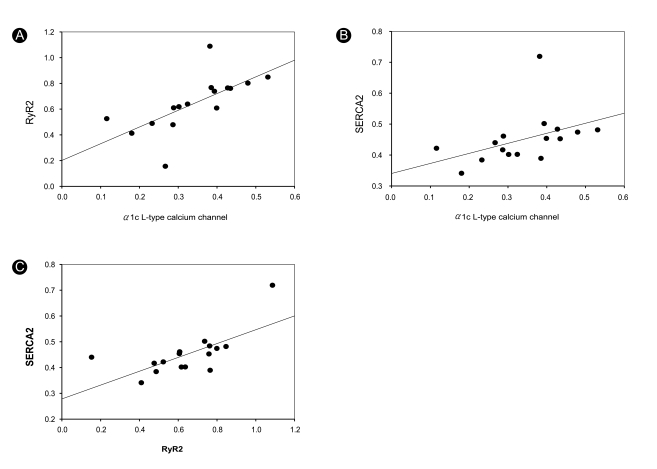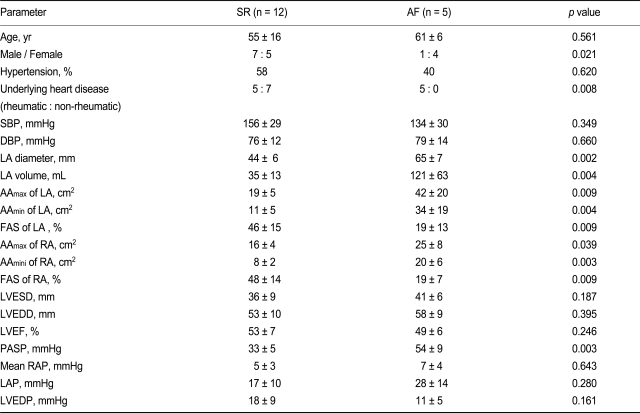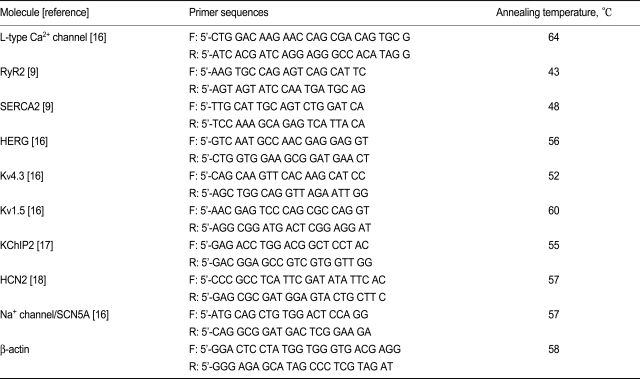1. Wijffels MC, Kirchhof CJ, Dorland R, Allessie MA. Atrial fibrillation begets atrial fibrillation. A study in awake chronically instrumented goats. Circulation 1995;92:1954ŌĆō1968PMID : 7671380.


2. Sun H, Chartier D, Leblanc N, Nattel S. Intracellular calcium changes and tachycardia-induced contractile dysfunction in canine atrial myocytes. Cardiovasc Res 2001;49:751ŌĆō761PMID : 11230974.


3. Nattel S. New ideas about atrial fibrillation 50 years on. Nature 2002;415:219ŌĆō226PMID : 11805846.


4. Van Wagoner DR, Pond AL, McCarthy PM, Trimmer JS, Nerbonne JM. Outward K+ current densities and Kv15 expression are reduced in chronic human atrial fibrillation. Circ Res 1997;80:772ŌĆō781PMID : 9168779.


5. Bosch RF, Zeng X, Grammer JB, Popovic K, Mewis C, Kuhlkamp V. Ionic mechanisms of electrical remodeling in human atrial fibrillation. Cardiovasc Res 1999;44:121ŌĆō131PMID : 10615396.


6. Van Wagoner DR, Pond AL, Lamorgese M, Rossie SS, McCarthy PM, Nerbonne JM. Atrial L-type Ca2+ currents and human atrial fibrillation. Circ Res 1999;85:428ŌĆō436PMID : 10473672.


7. Allessie MA, Boyden PA, Camm AJ, et al. Pathophysiology and prevention of atrial fibrillation. Circulation 2001;103:769ŌĆō777PMID : 11156892.


8. Van Wagoner DR, Nerbonne JM. Molecular basis of electrical remodeling in atrial fibrillation. J Mol Cell Cardiol 2000;32:1101ŌĆō1117PMID : 10888261.


9. Lai LP, Su MJ, Lin JL, et al. Down-regulation of L-type calcium channel and sarcoplasmic reticular Ca (2+)-ATPase mRNA in human atrial fibrillation without significant change in the mRNA of ryanodine receptor, calsequestrin and phospholamban: an insight into the mechanism of atrial electrical remodeling. J Am Coll Cardiol 1999;33:1231ŌĆō1237PMID : 10193721.


10. Lai LP, Su MJ, Lin JL, et al. Measurement of funny current (I(f)) channel mRNA in human atrial tissue: correlation with left atrial filling pressure and atrial fibrillation. J Cardiovasc Electrophysiol 1999;10:947ŌĆō953PMID : 10413374.


11. N├żbauer M, Beuckelmann DJ, Erdmann E. Characteristics of transient outward current in human ventricular myocytes from patients with terminal heart failure. Circ Res 1993;73:386ŌĆō394PMID : 8330381.


12. Jeck C, Pinto J, Boyden P. Transient outward currents in subendocardial Purkinje myocytes surviving in the infarcted heart. Circulation 1995;92:465ŌĆō473PMID : 7634462.


13. Greenstein JL, Wu R, Po S, Tomaselli GF, Winslow RL. Role of the calcium-independent transient outward current I(to1) in shaping action potential morphology and duration. Circ Res 2000;87:1026ŌĆō1033PMID : 11090548.


14. An WF, Bowlby MR, Betty M, et al. Modulation of A-type potassium channels by a family of calcium sensors. Nature 2000;403:553ŌĆō556PMID : 10676964.


15. Decher N, Uyguner O, Scherer CR, et al. hKChIP2 is a functional modifier of hKv4.3 potassium channels: cloning and expression of a short hKChIP2 splice variant. Cardiovasc Res 2001;52:255ŌĆō264PMID : 11684073.


16. Brundel BJ, Van Gelder IC, Henning RH, et al. Ion channel remodeling is related to intraoperative atrial effective refractory periods in patients with paroxysmal and persistent atrial fibrillation. Circulation 2001;103:684ŌĆō690PMID : 11156880.


17. Ohya S, Morohashi Y, Muraki K, et al. Molecular cloning and expression of the novel splice variants of K(+) channel-interacting protein 2. Biochem Biophys Res Commun 2001;282:96ŌĆō102PMID : 11263977.


19. Ohkusa T, Ueyama T, Yamada J, et al. Alterations in cardiac sarcoplasmic reticulum Ca2+ regulatory proteins in the atrial tissue of patients with chronic atrial fibrillation. J Am Coll Cardiol 1999;34:255ŌĆō263PMID : 10400019.


20. Grammer JB, Zeng X, Bosch RF, K├╝hlkamp V. Atrial L-type Ca2+-channel, beta-adrenorecptor, and 5-hydroxytryptamine type 4 receptor mRNAs in human atrial fibrillation. Basic Res Cardiol 2001;96:82ŌĆō90PMID : 11215536.


21. van der Velden HMW, van der Zee L, Wijffels MC, et al. Atrial fibrillation in the goat induces changes in monophasic action potential and mRNA expression of ion channels involved in repolarization. J Cardiovasc Electrophysiol 2000;11:1262ŌĆō1269PMID : 11083247.


22. Grammer JB, Bosch RF, Kuhlkamp V, Seipel L. Molecular and electrophysiological evidence for "remodeling" of the L-type Ca2+ channel in persistent atrial fibrillation in humans. Z Kardiol 2000;89(Suppl 4):IV23ŌĆōIV29PMID : 10810774.


23. Grammer JB, Bosch RF, K├╝hlkamp V, Seipel L. Molecular remodeling of Kv4.3 potassium channels in human atrial fibrillation. J Cardiovasc Electrophysiol 2000;11:626ŌĆō633PMID : 10868735.


24. Nakashima H, Kumagai K, Urata H, Gondo N, Ideishi M, Arakawa K. Angiotensin II antagonist prevents electrical remodeling in atrial fibrillation. Circulation 2000;101:2612ŌĆō2617PMID : 10840013.


25. Madrid AH, Bueno MG, Rebollo JM, et al. Use of irbesartan to maintain sinus rhythm in patients with long-lasting persistent atrial fibrillation: a prospective and randomized study. Circulation 2002;106:331ŌĆō336PMID : 12119249.












 PDF Links
PDF Links PubReader
PubReader ePub Link
ePub Link Full text via DOI
Full text via DOI Download Citation
Download Citation Print
Print



